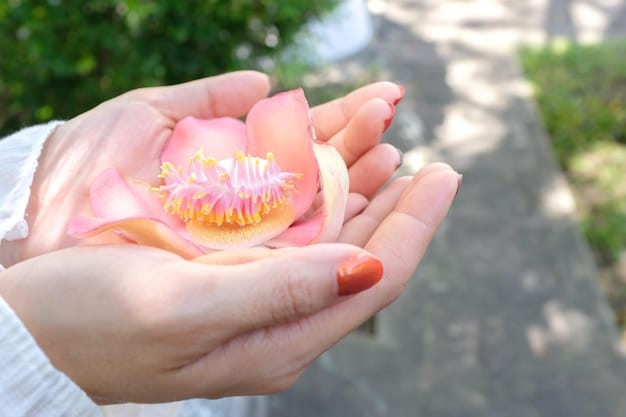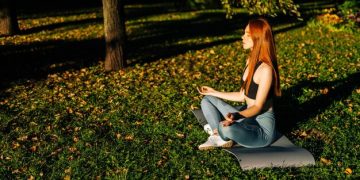Unlock Inner Peace: Mindfulness Techniques for Stress Reduction

Unlock inner peace through proven mindfulness techniques, reducing stress by 25% in adults and promoting a calmer, more balanced life.
Are you feeling overwhelmed by the daily grind? Discovering inner peace might seem like a distant dream, but it’s more accessible than you think. These 3 mindfulness techniques are designed to unlock inner peace and reduce stress by 25% in adults.
The Power of Mindfulness: Stress Reduction’s Secret Weapon
Mindfulness is more than just a buzzword; it’s a powerful tool for managing stress and cultivating inner peace. It involves paying attention to the present moment without judgment, allowing you to observe your thoughts and feelings without getting carried away by them.
By practicing mindfulness, you can become more aware of your stress triggers and develop healthier coping mechanisms. This awareness can lead to a significant reduction in stress levels and an overall improvement in your well-being.
What is Mindfulness?
Mindfulness is the practice of purposely focusing your attention on the present moment and accepting it without judgment. It’s about being aware of your thoughts, feelings, bodily sensations, and surrounding environment.
Benefits of Mindfulness for Stress Reduction
Mindfulness offers many benefits. Here are some examples:
- Reduce anxiety and depression symptoms
- Improve sleep quality
- Increase self-awareness and emotional regulation
Mindfulness is about living in the present moment and not stressing the past or the future.

Technique 1: Mindful Breathing – Your Instant Stress Reliever
Mindful breathing is a simple yet effective technique. It involves focusing your attention on your breath as it enters and leaves your body. This practice can be done anywhere, anytime, making it a convenient stress-relieving tool.
By focusing on your breath, you anchor yourself in the present moment, diverting your attention from stressful thoughts and worries. Regular practice can lead to a calmer mind and a more relaxed body.
How to Practice Mindful Breathing
Mindful breathing is very simple:
- Find a quiet place where you won’t be disturbed.
- Sit comfortably and close your eyes.
- Focus on your breath as it enters and leaves your body.
As you inhale, notice the sensation of the air filling your lungs. As you exhale, feel the air leaving your body. If your mind wanders, gently redirect your attention back to your breath.
Incorporating Mindful Breathing into Your Daily Routine
Here are some strategies to incorporate mindful breathing:
- Set aside 5-10 minutes each day for dedicated practice.
- Use mindful breathing as a quick stress-reliever during challenging moments.
- Practice mindful breathing during your commute or before bedtime.
Mindful breathing is not about stopping your thoughts; it’s about observing them without judgment. With practice, you’ll find it easier to stay present and manage stress more effectively.
Technique 2: Body Scan Meditation – Unlocking Body Awareness and Relaxation
Body scan meditation involves systematically bringing awareness to different parts of your body, noticing any sensations without judgment. This practice helps you to become more attuned to your body’s signals and release tension.
Regular body scan meditations can increase your ability to identify and address physical tension, reducing stress and promoting relaxation. It’s an excellent way to reconnect with your body and foster a sense of inner peace.
Performing a Body Scan Meditation
Here is a brief example of how to perform a body scan:
- Lie down in a comfortable position and close your eyes.
- Start by focusing on your toes and noticing any sensations.
- Gradually move your attention up through your body.
Pay attention to any sensations you experience along the way, such as tingling, warmth, or tension. Simply observe these sensations without trying to change them.
Benefits of Body Scan Meditation
Body scan Meditation helps with many things, such as:
- Reducing physical tension and discomfort
- Increasing body awareness and self-awareness
- Promoting relaxation
Remember, the goal is not to achieve a specific state but to observe your body with curiosity and acceptance. Over time, this practice can help you release tension and cultivate a deeper sense of relaxation.

Technique 3: Mindful Walking – Finding Peace with Every Step
Mindful walking combines the benefits of exercise with the practice of mindfulness. As you walk, you focus your attention on the sensations of your feet making contact with the ground, the movement of your body, and the sights and sounds around you.
This practice can help you to break free from repetitive thought patterns and experience a deeper connection with your surroundings. It’s a simple yet powerful way to reduce stress and cultivate a sense of presence.
Engaging in Mindful Walking
Below are some tips on how to engage in mindful walking:
- Choose a quiet place with minimal distractions.
- Walk at a slow, comfortable pace.
- Focus on the sensations of your feet making contact with the ground.
Pay attention to the rhythm of your steps and the movement of your body. Notice the sights, sounds, and smells around you, without getting lost in thought.
Integrating Mindful Walking into Your Day
Try to integrate mindful walking into your routine with these tips:
- Take a mindful walk during your lunch break.
- Use mindful walking as a way to transition between tasks.
- Incorporate mindful walking into your exercise routine.
Mindful walking can be done anywhere, anytime. By bringing awareness to each step, you can transform a simple walk into a powerful mindfulness practice.
Measuring the Impact: How Mindfulness Reduces Stress
While the subjective experience of reduced stress is valuable, research also supports the effectiveness of mindfulness techniques. Studies have shown that regular mindfulness practice can lead to measurable reductions in stress hormones and improvements in overall well-being.
One study found that participants who practiced mindfulness meditation for eight weeks experienced a 25% reduction in perceived stress levels. This demonstrates the tangible benefits of incorporating mindfulness into your daily life.
Scientific Evidence Supporting Mindfulness
There are several studies that proves the usefulness of mindfulness, for example:
- Improved mental health
- Better physical health
- Enhanced well-being
The science behind mindfulness is clear: regular practice can have a transformative impact on your stress levels and overall quality of life. It’s a practical, evidence-based approach to cultivating inner peace.
Tips for Sustaining Your Mindfulness Journey
Starting a mindfulness practice is one thing, but sustaining it over the long term requires dedication and consistency. Here are some tips to help you stay on track and deepen your practice.
Mindfulness is a journey, not a destination. There will be times when you feel more present and centered than others. The key is to keep practicing and be patient with yourself.
Building a Consistent Mindfulness Routine
Making time for practice can be tough, but here are some tips:
- Start small and gradually increase the duration of your practice sessions.
- Find a quiet space where you can practice without distractions.
- Use a mindfulness app or guided meditation to stay motivated.
With consistent effort, you can create a sustainable mindfulness routine that supports your well-being for years to come.
Potential Challenges and How to Overcome Them
While mindfulness offers many benefits, it’s not always easy. You may encounter challenges along the way, such as a wandering mind, physical discomfort, or resistance to sitting still.
The important thing is to approach these challenges with patience and self-compassion. Remember that mindfulness is a skill that takes practice to develop.
Addressing Common Obstacles in Mindfulness Practice
Below, you’ll see some of the main challenges people face:
- Wandering Mind: Gently redirect your attention back to your breath or body.
- Physical Discomfort: Adjust your posture or try a different meditation position.
- Resistance: Acknowledge your resistance and approach your practice with curiosity.
Mindfulness is not about eliminating challenges but about learning to work with them. Every obstacle is an opportunity to deepen your awareness and cultivate greater resilience.
| Key Point | Brief Description |
|---|---|
| 🧘 Mindful Breathing | Focusing on your breath to stay present and reduce stress. |
| 🙇 Body Scan Meditation | Bringing awareness to different body parts to release tension. |
| 🚶 Mindful Walking | Focusing on your steps and surroundings to find peace. |
Frequently Asked Questions
▼
Mindfulness is the practice of paying attention to the present moment without judgment, allowing you to observe your thoughts and feelings without getting carried away.
▼
Mindful breathing anchors you in the present, distracting from stressful thoughts and promoting relaxation by focusing on the sensation of each breath.
▼
Body scan meditation involves systematically focusing on different body parts, noticing sensations without judgment to increase body awareness and promote relaxation.
▼
Mindful walking combines exercise with mindfulness, focusing on the sensations of walking and the environment to break thought patterns and cultivate presence.
▼
Mindfulness is a skill that develops with practice. Start with short sessions and be patient with yourself. Over time, it becomes easier to stay present.
Conclusion
By incorporating these three mindfulness techniques into your daily life, you can take significant steps towards reducing stress and unlocking inner peace. Remember, the journey of mindfulness is a continuous one, filled with opportunities for growth and self-discovery. Embrace the process, be patient with yourself, and enjoy the transformative power of presence.





